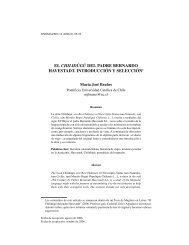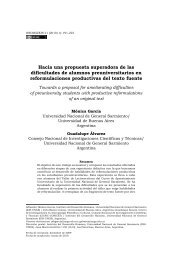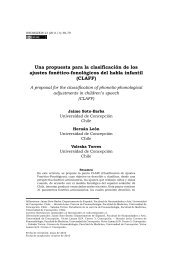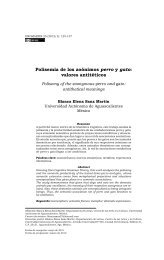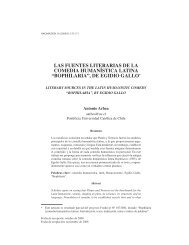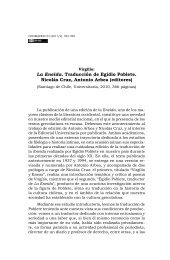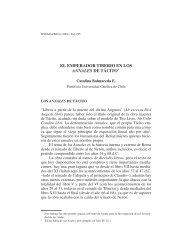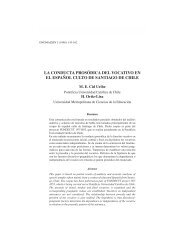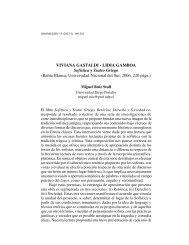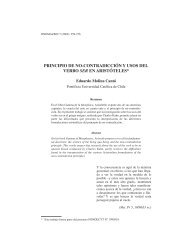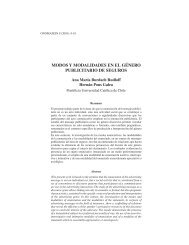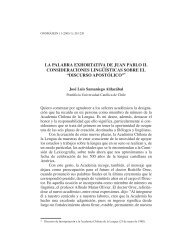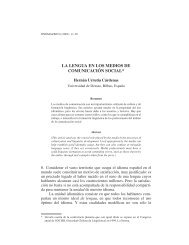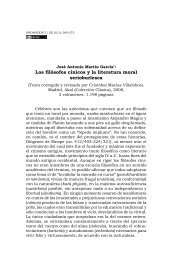El razonamiento analógico verbal: una habilidad ... - Onomázein
El razonamiento analógico verbal: una habilidad ... - Onomázein
El razonamiento analógico verbal: una habilidad ... - Onomázein
Create successful ePaper yourself
Turn your PDF publications into a flip-book with our unique Google optimized e-Paper software.
186 ONOMÁZEIN 22 (2010/2): 165-194<br />
Ricardo Benítez Figari, Georgina García Escala<br />
<strong>El</strong> <strong>razonamiento</strong> analógico <strong>verbal</strong>: <strong>una</strong> <strong>habilidad</strong> cognitiva esencial…<br />
BROWN, Ann y Mary KANE, 1988: “Preschool children can learn to<br />
transfer: Learning to learn and learning from example”, Cognitive<br />
Psychology 20, 493-523.<br />
CARRETERO, Mario, Julián ALMARAZ y Pablo FERNÁNDEZ, 1995: Razonamiento<br />
y comprensión, Madrid: Trotta.<br />
CLEMENT, John, 1993: “Using bridging analogies and anchoring intuitions<br />
to deal with students’ preconceptions in physics”, Journal<br />
of Research in Science Teaching, 30, 10, 1241-1257.<br />
COOPER, Charles y Lee ODELL, 1977: Evaluating writing. Describing,<br />
measuring, judging, Nueva York: National Council of Teachers<br />
of English.<br />
COOPER, David, 1990: Cómo mejorar la comprensión lectora (Trad. de J.<br />
Coger), Madrid: Visor Distribuciones.<br />
CRESPO, Nina, Ricardo BENÍTEZ y Carlos RAMOS, 2005: “Una propuesta<br />
de medición de las inferencias en la comprensión del discurso<br />
oral” en Mauricio PILLEUX (ed.): Los contextos del discurso. Valdivia:<br />
Asociación Latinoamericana de Estudios del Discurso (ALED)<br />
Filial Chile, 142-15.<br />
CRESPO, Nina, Ricardo BENÍTEZ y Pablo CÁCERES, 2007: “La comprensión<br />
oral del lenguaje no literal y su relación con la producción<br />
escrita en escolares”, Revista Signos: Estudios de Lingüística 40,<br />
63, 31-50.<br />
DUIT, Reinders, 1991: “On the role of analogies and metaphors in learning<br />
science”, Science Education 75, 6, 649-672.<br />
FERNÁNDEZ, José, Benigno GONZÁLEZ, Teodomiro MORENO, 2005: “La modelización<br />
con analogías en los textos de ciencias de secundaria”,<br />
Revista Eureka sobre Enseñanza y Divulgación de las Ciencias 2,<br />
3, 430-439.<br />
FIVUSH, Robyn y Catherine HADEN, 1997: Narrating and representing<br />
experience: Preschoolers’ developing autobiographical accounts.<br />
En P. W. van den Broek & P. J. Bauer (Eds.), Developmental spans<br />
in event comprehension and representation (pp.169-198). Hillsdale,<br />
NJ: Lawrence Erlbaum Associates.<br />
FLOWER, Linda y John HAYES, 1980: The dynamics of composing: Making<br />
plans and juggling constraints. En L.W. Gregg & E.R. Steinberg<br />
(eds.) Cognitive processes in writing, Hillsdale (N.J.): Erlbaum,<br />
pp. 31-50.<br />
GALOTTI, Kathleen, 1989: “Approaches to studying formal and everyday<br />
reasoning”, Psychological Bulletin 105, 331-351.<br />
GARCÍA, Georgina, 2008: “Razonamiento analógico <strong>verbal</strong> en escolares :<br />
Una propuesta de medición”, en Actas del XVII Congreso de la<br />
Sociedad Chilena de Lingüística.<br />
GARCÍA Georgina y Andrea PIZARRO, (s.f.): “Razonamiento analógico:<br />
Cómo evoluciona esta <strong>habilidad</strong> en los escolares”, Revista de<br />
Fonoaudiología.<br />
GENTNER, Dedre, 1983: “Structure-mapping: A theoretical framework<br />
for analogy”, Cognitive Science 7, 155-170.



